Day 2 of a 4-day Autumn Migration tour. The early mist quickly burnt off and we were left with a glorious sunny autumn day with oceans of blue skies. Not great for migrants but lovely weather to be out birding.
Our first destination this morning was Cley. We parked in front of Walsey Hills and two Little Grebes were diving on Snipe’s Marsh. A Water Rail squealed from somewhere in the reeds- the first of several we were to hear this morning. Several Chaffinches were chinking in the trees.
As we walked up towards the East Bank, some large skeins of Pink-footed Geese came up off the marsh, half flying off east past us and the rest going off west towards Blakeney Freshes. They would be coming and going all morning, accompanying us with their yelping calls, the sound of autumn and winter here.
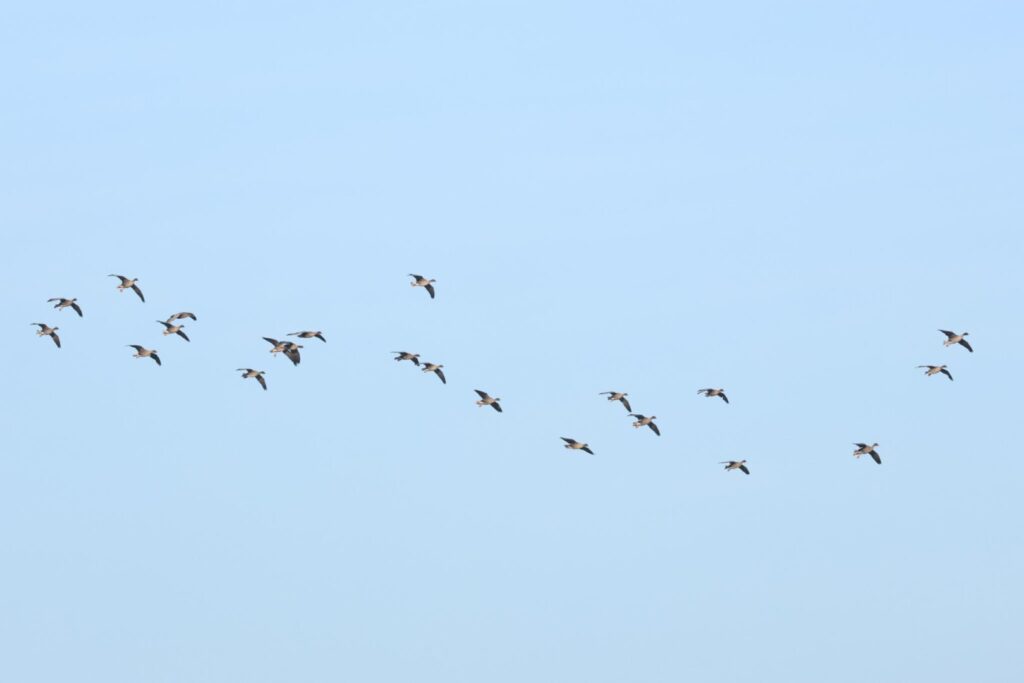
It seemed like a perfect morning for Bearded Tits, but the reedbed seemed rather quiet at first. A distant Marsh Harrier quartered over the reeds in front of the hides and flushed all the Lapwings off the scrapes. There were a couple of Dunnocks, Wrens and Blue Tits in the small sallow bushes the other side of the ditch. A couple of Cetti’s Warblers were calling and singing.
Finally, as we got a bit further up, we started to hear Bearded Tits calling. At this time of year, some of them are often in dispersal mode and so it proved today. A succession of small groups flew up out of the reeds calling. They circled higher and higher into the sky, until they were hard to see in the blueness. Several times, they then dropped sharply back down into the reeds, chickening out. But some did seem to reach escape velocity and we lost sight of them as they headed off east.
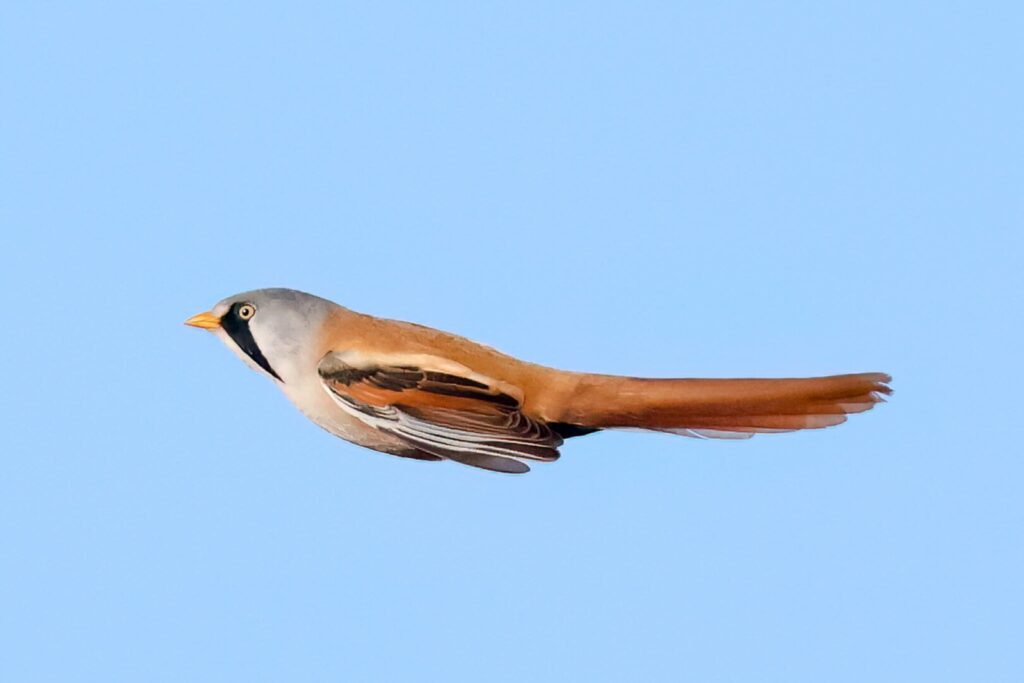
It is a real treat to stand and watch the Bearded Tits like this. But even better, one group dropped back into the reeds just the other side of the ditch and proceeded to feed on the seedheads. The light was perfect and we had fantastic views of them now in the scopes. We could see at least four males and two females in the reeds, but when they finally took off again and flew up into the sky we counted nine Bearded Tits in total. Stunning!
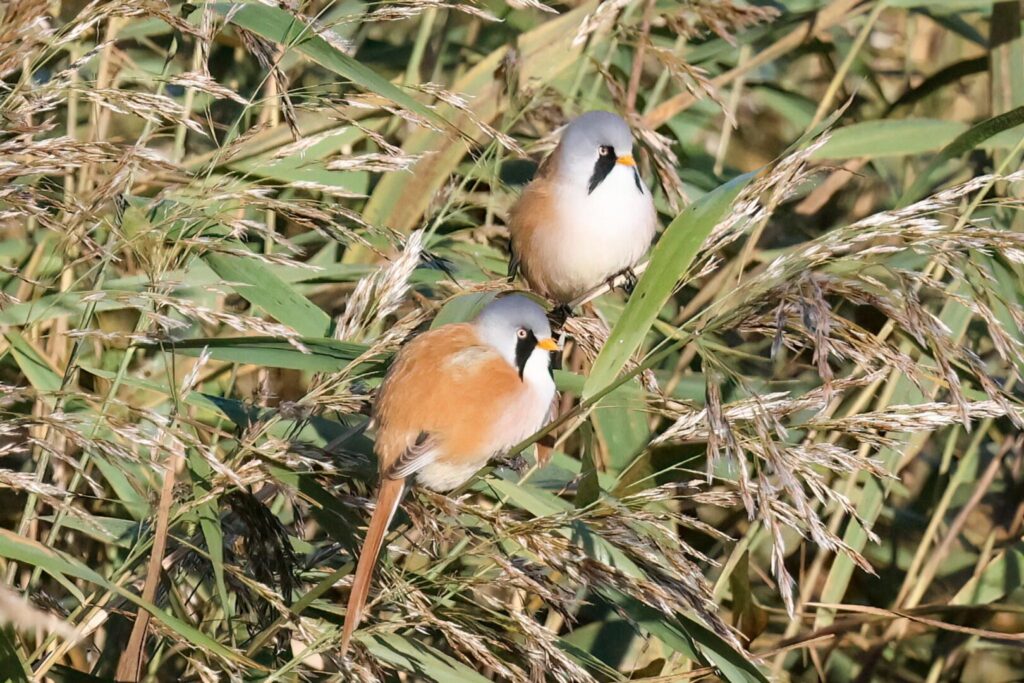
When we could tear our attention away from the Bearded Tits, there were other birds to see too. A Sparrowhawk perched in the tamarisk bush out in the reeds before flying off. A Great White Egret flew up from the reeds briefly.
Looking out over the grazing marsh the other side, we could see a single Canada Goose on Pope’s Marsh. For some reason, it didn’t attract the same excitement as the Bearded Tits! There were plenty of ducks on the Serpentine, but a a distinct lack of waders today. A small flock of Golden Plover flew over.
A pipit flew up from the wet grass giving a shriller call, a Water Pipit. It was chased by Meadow Pipit, the Water Pipit being clearly bigger, before it eventually dropped down again. It landed out of view at first, then we could just see it creeping through the grass. Thankfully it flew again, and landed back along the edge of the Serpentine much closer, where we finally had some better view through the scopes.
As we walked on towards the beach, all the waders came up off Arnold’s Marsh. A large flock of Curlew and a single Bar-tailed Godwit flew off west. Shortly afterwards, a large flock of Dunlin flew off too, accompanied by a single Knot with another Bar-tailed Godwit. They had presumably been pushed off Blakeney Harbour this morning by the high tide and were looking to head back out there. There were still lots of Redshanks left on Arnold’s Marsh and a few Curlew. A single Grey Plover flew round and landed on one of the shingle islands. Several Ruff were feeding in the saltmarsh along the southern edge.
Several Pintail were feeding out on the Brackish Pool the other side of the path. The drakes are starting to emerge from their eclipse plumage now, but have yet to get their long pin tails again.
There were still a few Starlings moving this morning, but not much else. Visible migration seemed to have dropped off significantly compared to yesterday. We heard several Skylarks calling, but even though some seemed to fly over heading west it was hard to tell if they were on the move or local birds. Three Lapwings did fly west.
Out to the beach, there was not much moving offshore today either. We could see a few Red-throated Divers out on the sea. There had been two Velvet Scoter hanging around offshore recently, and we eventually found them way off to the west, closer to the beach car park. An out of control dog was running around the other side of the fence, its owners furiously blowing on their dog whistle which the dog was completely ignoring. It splashed down into the edge of the Brackish Pool and came back out with something in its jaws. Thankfully it only appeared to be the rotting corpse of something long dead. It now ran back to its owners who seemed more interested in getting a video to put on social media!
We walked back to the minibus and drove round to the beach car park to see if we could get a closer view of the Velvet Scoters. There was no sign of them at first. We did find some closer Red-throated Divers, one in breeding plumage still. Its red throat caught the sun occasionally as it turned. There was a distant Great Crested Grebe out on the water too.
A juvenile Peregrine flew round over the Eye Field away to the east, flushing everything. It landed in the grass, though in a bit of a dip where it was hard to see at first. We got it in the scopes and eventually got a better view of it, preening.
A lot of the ducks flew out to sea, and some large rafts of Wigeon landed on the water. Some smaller flocks of Wigeon flew past too, but it was hard to tell if they were migrants arriving or not. A small group of Shelduck certainly appeared to be coming in from the continent. A few Redshanks and Sanderling flew past. Three Skylarks flew in off the sea and over the shingle – they surely must be migrants arriving.
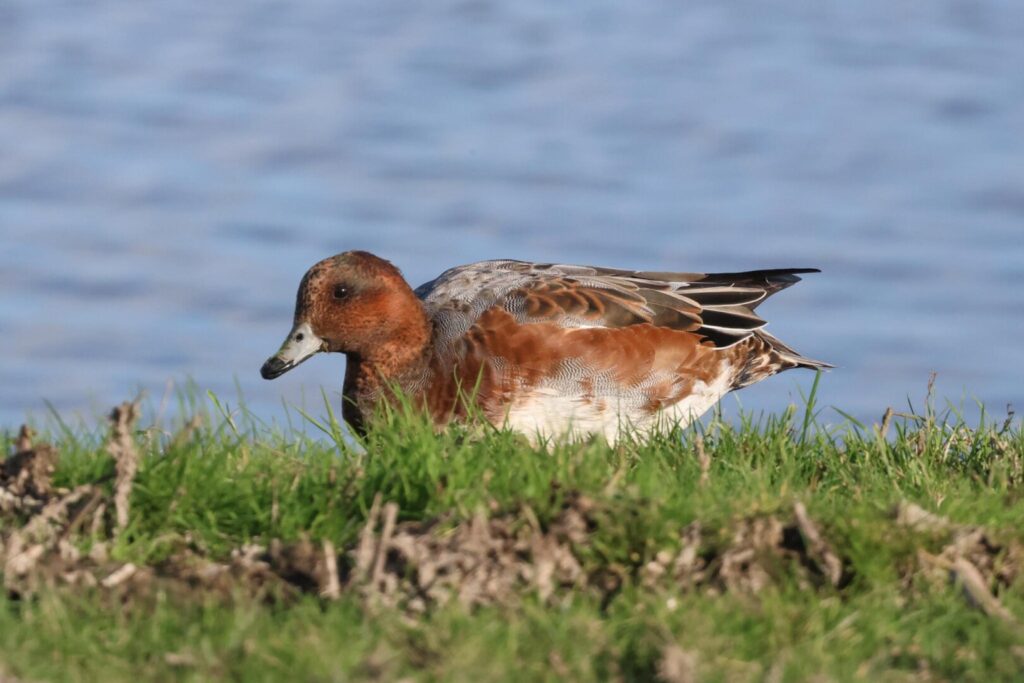
The Velvet Scoters eventually reappeared and we had much better views of them now, diving for shellfish offshore. Both females or juveniles, with two white spots on their faces.
Back round to the Visitor Centre, we checked in and headed out to Bishop Hide for a quick look before lunch. The Long-billed Dowitcher, which first arrived here in October 2022, had finally left us back in May. Then earlier this week it had returned with the Black-tailed Godwits, perhaps having accompanied them up to Iceland for the summer. Scanning round Pat’s Pool, we eventually found the Long-billed Dowitcher right over the far side, in front of Teal Hide. Not a great view, but we could see it through the scopes.
A Water Pipit had been reported from the hide here earlier too. Now it dropped in right in front. We had a great view of it as it fed on the bank, before it worked its way steadily back away from us. Much closer than the one we had seen on the Serpentine earlier.
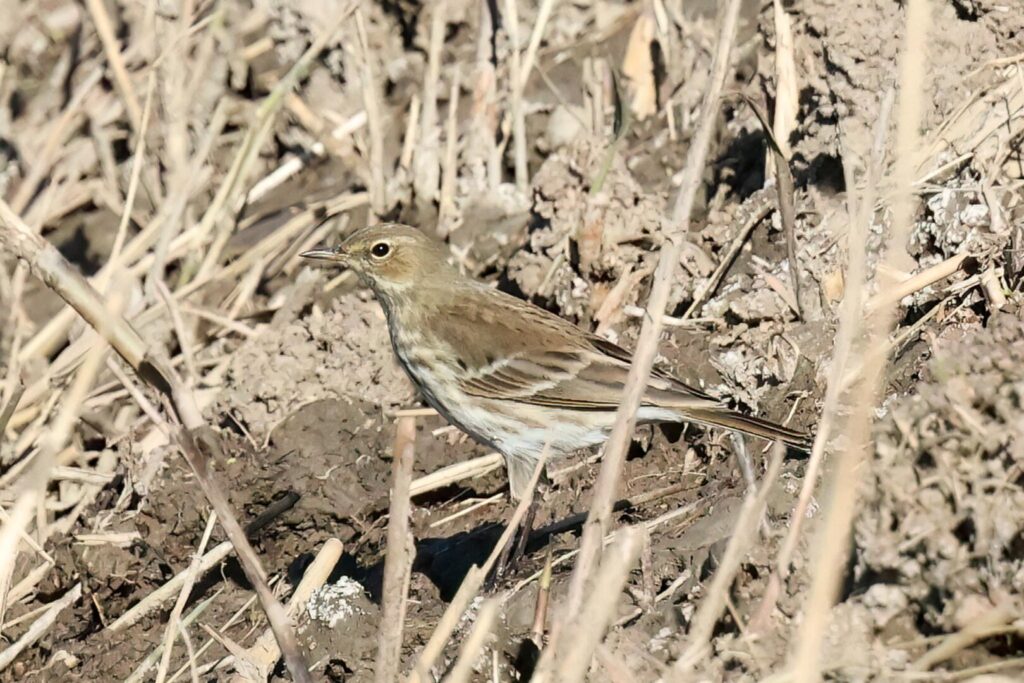
Back to the Visitor Centre, we stopped for lunch on the picnic tables out front. At least four Marsh Harriers were stirring things up, flying over the back of the scrape and occasionally landing on the bank. Everything flew up and whirled round and some waders flew off.
After lunch, we headed out to the central hides to see if we could get a better view of the Long-billed Dowitcher. Unfortunately, it appeared to have gone. There were still a few Black-tailed Godwits but no sign of it with them now.
There were lots of Ruff on the scrape, included one white-headed bird, a ‘satellite’ male. A single Avocet was still out here too, plus plenty of ducks. A winter adult Mediterranean Gull dropped in for a bathe, showing off its pure white wing tips.

Out on Simmond’s Scrape, there were lots of Lapwing and two Common Snipe with them out on the open mud. At least until everything was flushed by a Marsh Harrier drifting past. A few Black-tailed Godwits started to fly back in to Pat’s Pool, but there was still no further sign of the Dowitcher.
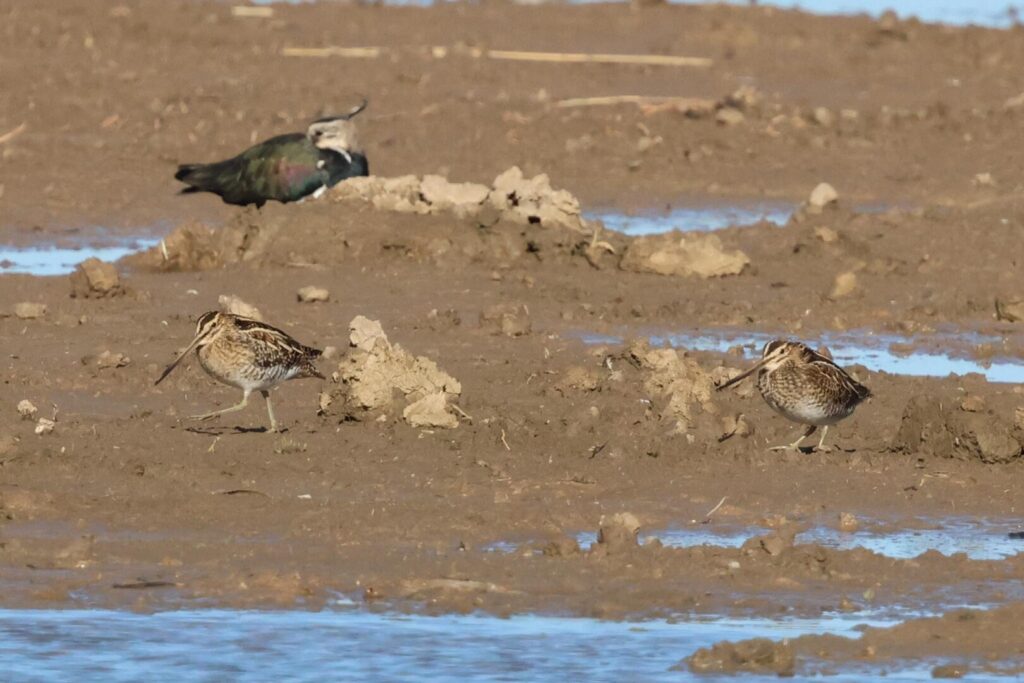
We decided to move on and have a walk somewhere different before the end of the day. Driving round to Kelling, we were just a few minutes early and it was still school run time. We had to park half way up the Holt road! As we walked down towards the coast road, the cars were just leaving.
At the top of the lane, a few Goldfinches and Chaffinches were in the trees by the school. Walking down, we could hear a Bullfinch calling ahead of us. Lots of Rooks and Jackdaws flew up from the field above the lane and a couple of Rooks landed in the trees ahead of us.

From the metal gates, we could see lots of Red-legged Partridges and Pheasants in the field beyond. This is a big shooting estate and they do like to release lots of these (non-native) birds. Opposite the water meadow further down, there were yet more Red-legged Partridges and a Brown Hare in the field to the west.
On the water meadow pool, there were several Wigeon and Gadwall, and a pair of Egyptian Geese. Lots of Linnets were in the bushes beyond, along with one or two Stonechats (sadly, we couldn’t repeat the trick of last month’s tour and find a rare one in with them!). A couple of Reed Buntings flew up into the trees on the corner. A juvenile Marsh Harrier drifted over.
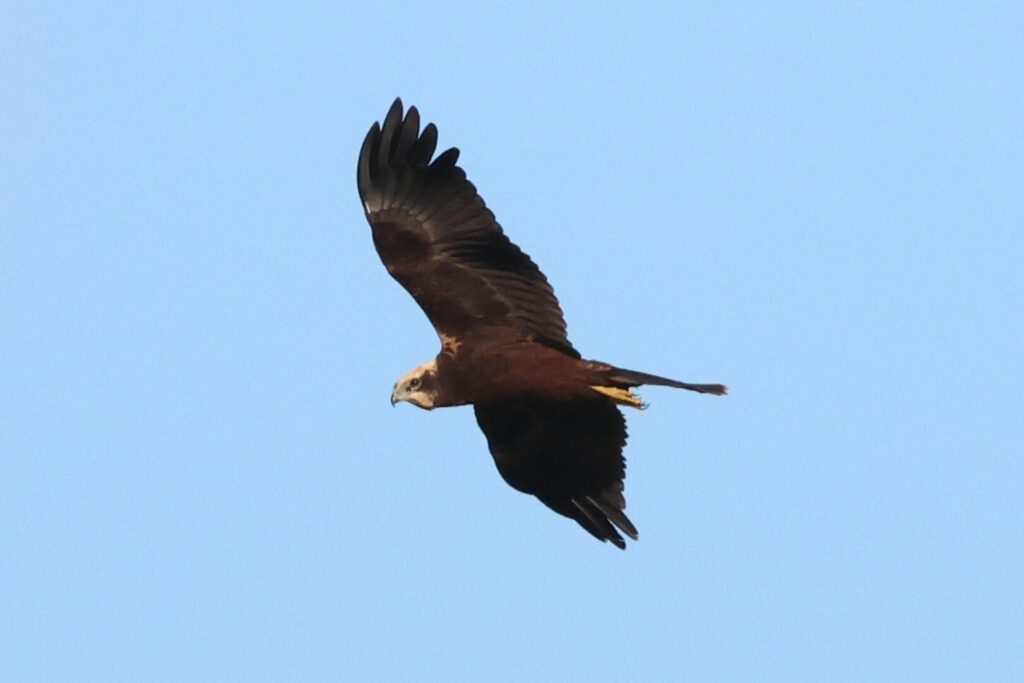
Walking on down towards the beach, one of the group spotted a single Wheatear out on the grass on the Quags. Always a good spot for them, but nice to catch up with one this late in the year. More Linnets flew up off the shingle ridge, a large flock, and a few more Stonechats were in the bramble field.
We turned up along the permissive path, up to the guns, past the distinctly ‘unsavoury’ no entry signs on the edge of the Camp. There was no sign of any birds up here today, and we were out of time now, so we turned to head back. A male Marsh Harrier was circling over the water meadow now, flushing everything, two Common Snipe flew round. Then it was back to the village and the minibus, and back to Hindolveston for dinner. More tomorrow.
















